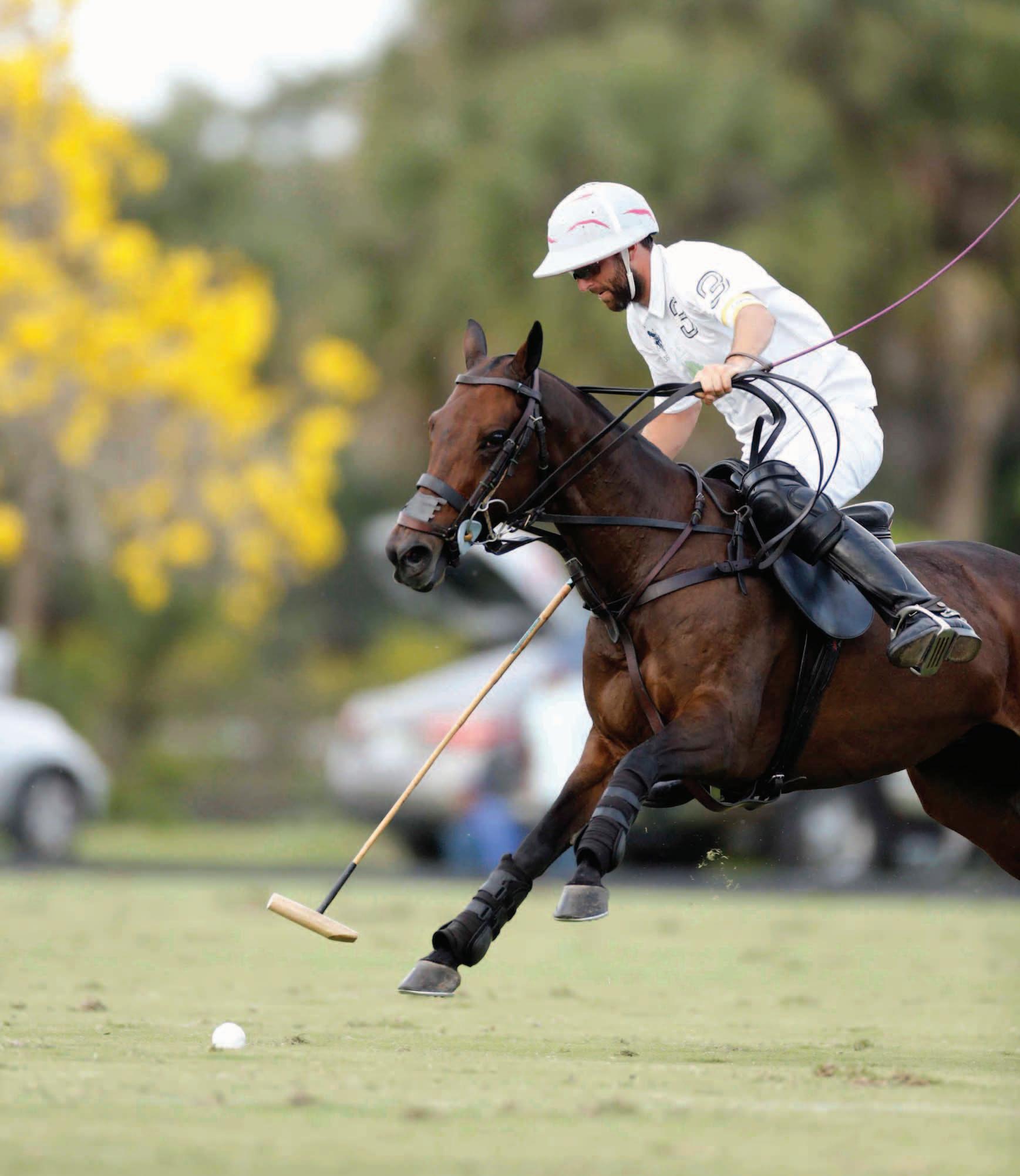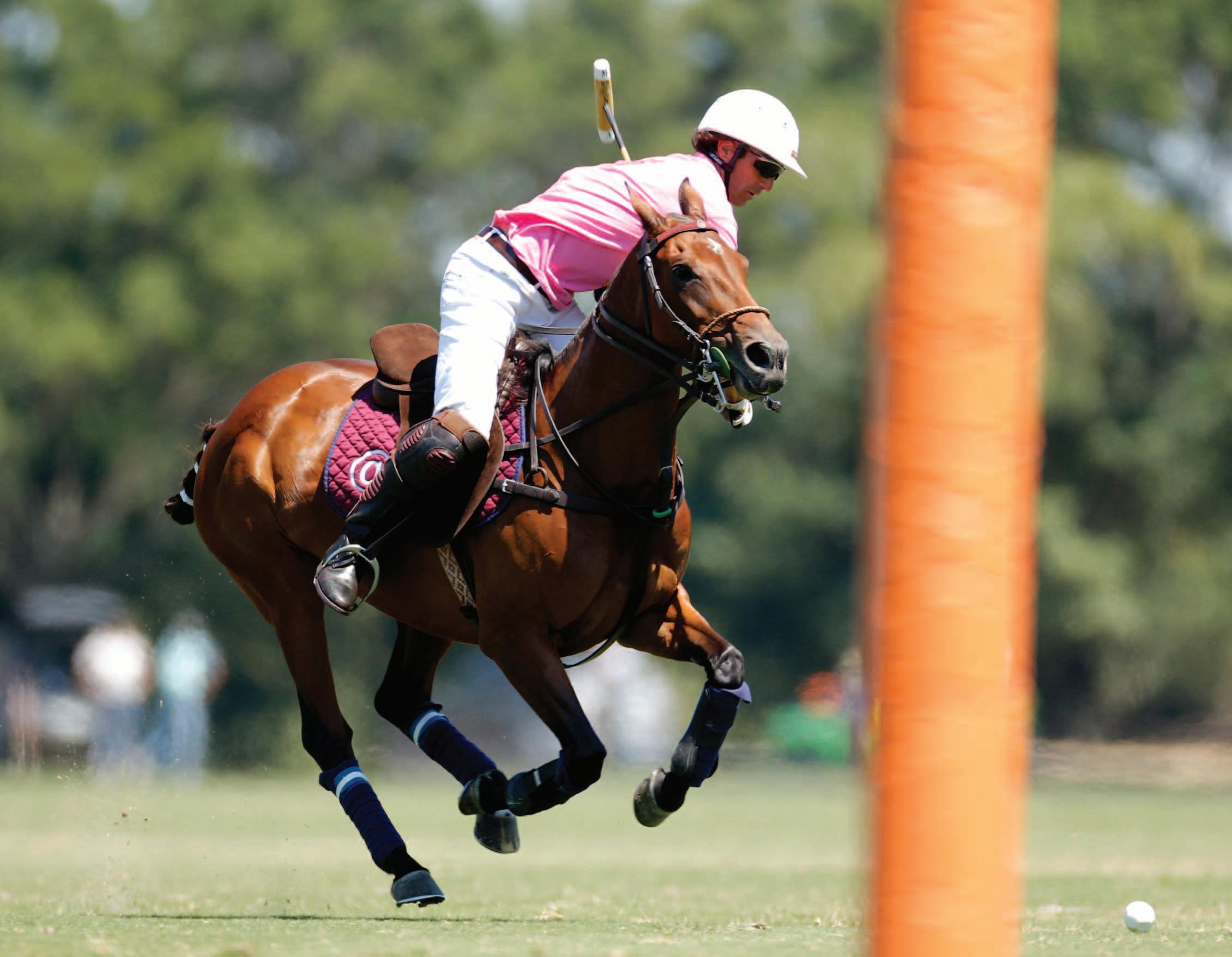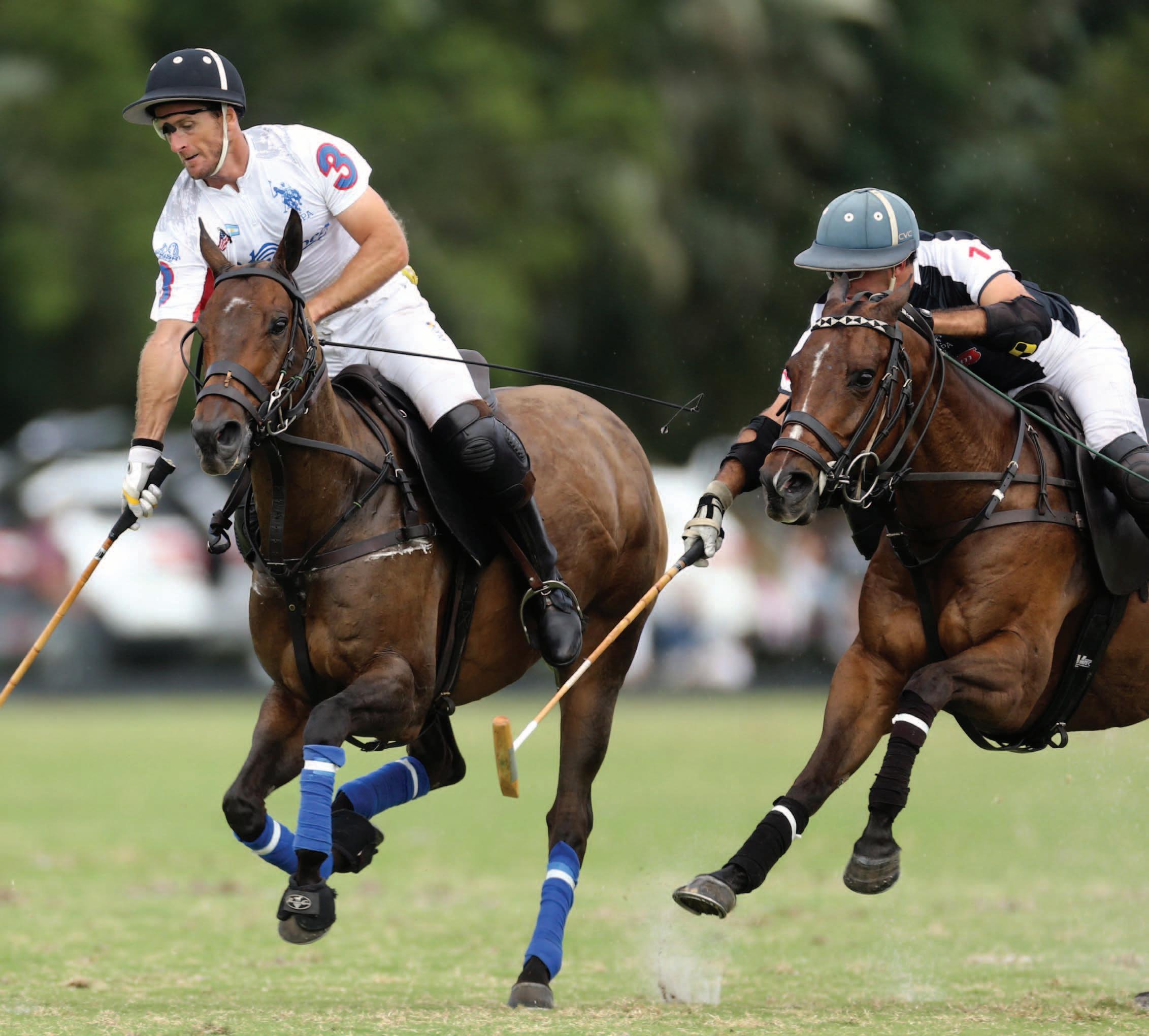
14 minute read
Standouts by Jewel Connelly/United States Polo Association
Standouts
Talented horses top players rely on
By Jewel Connelly/United States Polo Association
Photos by David Lominska/Polographics.com
Machitos Pangia
Owned by Polito Pieres
Peaking the interest of 10-goaler Polito Pieres with her impressive pedigree, Machitos Pangia catapulted her career as part of an elite string of equine athletes, quickly distinguishing herself to be one of his best at just 8 years old. Prized for her nimble athleticism and explosive acceleration, Machitos Pangia is the mare Pieres reserves for key plays in a tight game, especially adept at gaining momentum when the win is on the line. Handling on the field like a high-performance vehicle, she can effortlessly switch from incredible velocity to turning with pinpoint accuracy. Machitos Pangia matured her skills in the 2018 Tortugas Open, the first leg of the Argentine Triple Crown, before arriving stateside to compete for Aspen in the 2019 Gauntlet of Polo.
Playing the game with signature grit and flair, Pieres ascended through the ranks, joining his cousin Facundo Pieres to achieve the highest rating in 2015 at just 28 years old. Always in search of exceptional horses to match his level, Pieres has found the ingredients present in Machitos Pangia, a bay equipped with every gear as he challenged his three cousins and Gauntlet rivals Facundo, Gonzalito (Pilot) and Nico Pieres (Coca-Cola). Sitting down with Polito Pieres earlier this year the USPA learned about the young horse’s natural talent and how Pieres’ keen eye for recognizing quality quickly blossomed into a solid partnership.
What is her breeding?
Machitos Pangia is by Durazno (Pucara x Guinda), a Los Machitos stallion, and out of Pandora, an American Thoroughbred mare that John Muse owned and Mariano Aguerre played in the Argentine Open in 2010. Muse purchased Pandora from Scott Devon in 2009. Todd Offen, who played for Devon and managed his string, found Pandora in Canada. Aguerre agreed to give Muse access to Durazno in exchange for allowing him to play Pandora in the Argentine Open.
How did Machitos Pangia come to your string?
I tried her in Argentina from Andres Weisz, John Muse’s operating partner in their joint breeding program in Argentina. When I first tried her, I loved her mouth and how sensitive she was. She stopped really well and although she didn’t run much, I knew she would run with me. She could stop really fast, so I didn’t care about the speed, but as soon as I got her I played a couple of practices and then she started running more. I played her in the Tortugas Open when she was 7 years old. She played in Argentina for a little bit and then I sent her to Florida. Last year she was one of my best horses.
What chukker do you typically play her?
I normally play her in the beginning of the game because she is amazing in the first chukker. I also want to save her for the fifth or sixth chukker. I always try to bring her out when we are losing, during a tied game or in the last couple of minutes because on her I know I can score a goal or make a nice play for my teammates.
Does she have any other siblings who play?
Machitos Petrus is a full sister who I play in the Argentine Open. Michael Bickford played Machitos Pontiac, a full brother of Machitos Pangia, in the Gauntlet of Polo. John Muse plays Machitos Prisa, another full sister to Pangia and played her in California this summer. Although Pandora passed
away two years ago she has a number of other daughters who show a lot of promise and are still in training in Argentina.
What are her best qualities on the field?
She is a different horse from the rest of my string. Her mouth is amazing; when you pull her just a little bit she almost steps backwards. There was a goal I scored on her on Facundo [Pieres] during the first chukker of the 2019 USPA Gold Cup final, which has not happened many times. She stops and goes backwards, but she also has a lot of explosion. She is a mare I can count on to stop quickly, turn quickly, plus she’s fast and intelligent. She has many qualities that make a good horse.
Polito Pieres and Machitos Pangia
Describe her personality?
In the barn she is very quiet, but when you ride and play her she acts a little crazy, in a good way. At the beginning of the season in the first practices she likes to buck and jump when you start riding and she’s a little mean, but I think good horses are like that sometimes. She’s kind of a character.
What are your plans for her future?
In two years I could see her in Argentina playing with La Natividad. She is still young so for right now I plan to play her for a couple of years here in Florida. She had a long rest in Virginia and hopefully we can play the entire 2021 Gauntlet of Polo together.
Miguel Novillo Astrada and @One
@One
Owned by Miguel Novillo Astrada
Becoming partners by pure chance, @One’s destiny was set before the mare was even born, granting Miguel Novillo Astrada the opportunity to develop the competitive talent of his beloved Manzanita in her progeny. Descending from a lineage of greatness with both racing and polo blood in her veins, Novillo Astrada’s @One is the result of a superior combination of bloodlines from around the world. Her mother, Manzanita, is a twotime Argentine Triple Crown winner. @One proved the quality of her pedigree at the early age of 6, winning Best Playing Pony at the 26-goal level during her first year in the United States. The promising odds working in Novillo Astrada’s favor, the now 9-year-old bay is both calm and collected in hand and easy to navigate on the field, making her one of the most reliable horses in the former 10goaler’s string.
Broken at La Aguada, the family farm in Argentina, by Bucky Pistone, @One’s greatest asset is versatility at a high level. She has competed in tournaments such as the Copa Cámara de Diputados in Argentina, as well as the U.S. Open Women’s Polo Championship with Novillo Astrada’s daughter, Mia. Hoping to carry on the exceptional bloodline after her competitive career is over, Astrada sees many qualities reminiscent of her accomplished mother. Sitting down with Miguel Novillo Astrada, he spoke about his stroke of good luck in receiving @One, the mare who was seemingly destined to be a part of the current 9goaler’s Old Hickory Bourbon lineup in the Gauntlet of Polo.

What is her breeding? @One is by Rayo Gringo and out of Manzanita. Rayo Gringo (River Slaney x Giusti) was a stallion who was playing in the Argentine Open, and we
thought it was a great opportunity to breed him with a good mare, which worked out really well. Ellerston Australia originally acquired Manzanita from New Zealand, and from Australia she went to England and then Argentina. We decided to breed Rayo Gringo and Manzanita because we already had some babies from Manzanita and River Slaney who were successful polo ponies.
River Slaney (Irish River x Chancy Prospect) is an American Thoroughbred we purchased from Gulfstream Park in Hallandale Beach, Florida, and brought to Argentina. Gil Johnston was helping me search and actually found River Slaney. We were searching for a direct bloodline to Riverman, a wellknown American Thoroughbred stallion, but we couldn’t find one so that’s why instead we chose one from Riverman’s best sons, Irish River.
How did @One come to be in your string?
I played @One’s mother Manzanita in the Argentine Open in 2003 when my brothers (Javier, Eduardo and Nacho) and I won the Argentine Triple Crown with our team La Aguada. She was a spare I used throughout the game, but I was on her in the last few minutes of the Argentine Open final. Manzanita also won the Triple Crown with Gonzalo Pieres in 1994.
When we were playing for Ellerstina, my brothers and I had the choice to buy a couple of horses and we picked her even though she was a little older. She ended up being a really good broodmare and there are many babies of hers that play in the Argentine Open. @One was the last embryo of Manzanita’s so my brothers and I had to draw a number (one through three) out of a hat to see who was going to keep that embryo. I picked number one so I decided that was going to be her name when she was born.
Does @One have any siblings who play?
I sold her half-sister Tentación, another mare out of Manzanita, to Will Johnston, who played her in the Gauntlet. My older brother Eduardo owns Wallaby, a mare he played in the Argentine Open for many years and a horse I also played a lot. My other brother Javier had another half-sister of @One named Rayo Mandarina, who was by River Slaney and out of Manzanita. She was one of his best mares for many years.
When did you know she would be a great horse in your string?
She was green, but she had potential and I already knew her bloodline really worked well from her siblings. I was confident she was also going to be a really good horse, but she really surprised me. I started playing her when she was 5 in slower chukkers, and the first tournament I played her in was the Copa Cámara de Diputados that year. I was not planning to play her and although she was a little young for the 28-goal level she did great and from then on, she always played high-goal polo.
I brought her from Argentina to the United States in 2016 and she played really well the same year. She was only 6 years old, but I played her in the 26-goal USPA Gold Cup and she did so well she won Best Playing Pony in the quarterfinals.
What are @One’s strengths on the field?
She’s very handy, quick and has a really good mouth. She is always ready to go and always plays the same—she’s a natural on the polo field. She is a mare that anyone can play. Gillian Johnston and my daughter Mia both play her, she is very easy.
When I play her I feel very confident and safe. She is always really solid when she runs and is very strong even though she’s not tall. She is always with you, when you need to stop, she stops really well. Although she is not the fastest, her quickness gives you time to recover immediately if you make a mistake because she will do anything to get you back in any play.
What chukkers do you typically play her?
I always play her for a few minutes at the beginning of the game and then save her for the fifth and sixth chukkers. I either start on her in the last chukker or keep her as a spare because she is very quiet on the pony line. Usually I finish most of the game on her because she’s very reliable and very comfortable for me to hit penalty shots.
What is your favorite playing memory on @One?
In the USPA Gold Cup quarterfinal in 2016, I played her in the third and sixth chukkers. In the final chukker, I passed everybody and scored a very important goal. Also, during the 2019 U.S. Open Women’s Polo Championship, my daughter Mia got possession of the ball, turned and ran out in front of everybody to score a great goal.
What are your plans for her future?
Hopefully in the next five years she will continue playing with myself, Mia or my son Miguel. After that I will definitely breed her because I think she has demonstrated how valuable her bloodline is.
Cali Marino
Owned by Tomas Garcia del Rio
Showing tremendous potential as a young horse, Tomas Garcia del Rio’s rambunctious gelding Cali Marino has earned his place at the forefront of the 8 goaler’s string. Arriving from Argentina four years ago, the now 10-year-old Cali Marino has developed into Garcia del Rio’s top horse, garnering the Best Playing Pony blanket during the 2018 Silver Cup final at Greenwich Polo Club in Greenwich, Connecticut. Carrying the heart of a Thoroughbred champion and the recognition of the Ellerstina bloodline, Cali Marino has proved himself time and time again to be trusted with the outcome of pivotal games as a faithful sixthchukker horse.
Started by Marco Luther and made by Carlos Rodriguez in Argentina, Cali Marino was refined and finished in the United States, playing 20- to 26goal polo.
Counted upon to unleash undeniable power on the field with devouring strides, Cali Marino’s agility and endurance is the key to many victories over the last several years. Sitting down at Patagones’ Wellington-based barn earlier this year, the USPA spoke to Garcia del Rio about what ingredients his complete gelding possesses which make him such an asset in high-goal competition.
What is his breeding?
A homebred from Argentina, Cali Marino by Open Tintero (Open Sunset x Ellerstina Tinta), a stallion from Ellerstina, and out of Marinera [Spanish for sailor], a Thoroughbred mare I played for many years in Argentina. Marinera was very fast, strong and had a lot of stamina, and Cali Marino has similar qualities except he is even better.
Marinera and Open Tintero were at the same embryo center, and since I didn’t have many other horses by that stallion I decided to breed them. He only has one sister, but she is a 2-year-old green horse that is just now being trained.
When did you know he would be your best horse?
I brought him over from Argentina as a green horse when he was 6 years old because he already looked like he was going to be a really good high-goal horse, and I finished him here in the states. He started playing 20-goal polo at Greenwich Polo Club when he arrived and he has been playing with me in Wellington, Florida, for the last four seasons.
I knew he would be my best horse the first year I brought him here. I played him for one year in Argentina when he was still green and he was very good, but when he arrived in the U.S., I realized he was going to be great. He already had all the qualities, but he was still a bit green when he first arrived. He just needed more playing experience and he became more developed once he got a bit older.

What are Cali Marino’s strengths on the field?
His best qualities are that he is very fast, strong and he doesn’t get tired quickly. In important games, many times I play him the entire chukker and he has the same power in the first play as in the last. He also has a great temperament, and he is very comfortable, calm and easy to hit the ball off of.
I’ve won a lot of games playing him in the last chukker, especially because he is a very good horse to defend on. It is quite hard for other horses to get by him. In every game, he is my best horse and he is very consistent, performing well nearly every time he plays. I want to play him as often as I can for as long as I can throughout his career.
Describe his personality.
In the barn he does whatever he wants, and everybody knows he is the best horse in the barn. Every day we go to the barn, the grooms and I visit his stall first to see how he is doing.
At the field, he gets nervous and he moves around a lot. It is not easy because you need three or four grooms to tack him up, but when he gets on the field, he is really calm, steady and easy-going.

Which chukkers do you typically play him?
Regardless if we are winning or losing, I always want to be on Cali Marino in the last chukker of the game. I try to finish the game on him because he is a horse I have a lot of confidence on and he is always very steady. He always plays the same in every game and he always performs well. He has been an important part of every game I’ve played in the last couple of years.
What are your plans for him next year? He will be ready the 2021 Florida season.
Tomas Garcia del Rio and Cali Marino










